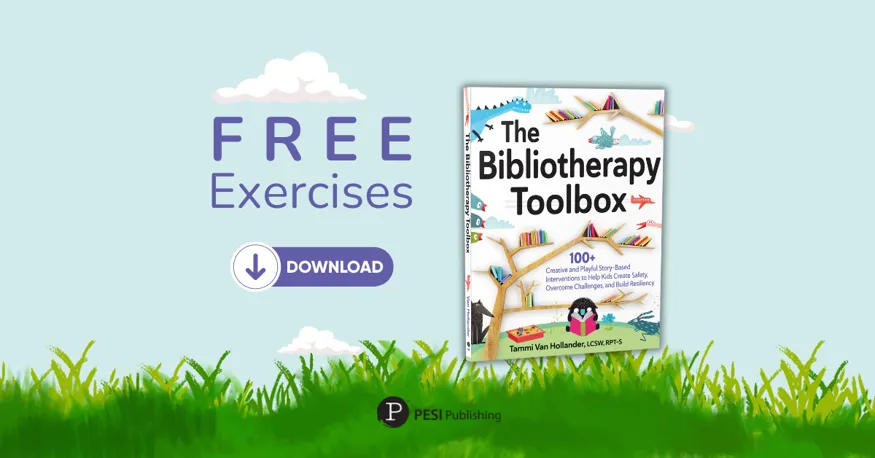The Power of Bibliotherapy: Using Stories to Help Clients

I have been a play therapist for children and families for over 20 years. Having been trained as a client-centered play therapist, the idea of using books therapeutically was never introduced to me. It was not until I attended my first Association for Play Therapy Conference that I met Dee Dee Gruenberg, the owner of The Self-Esteem Shop at the time. She would pick up books and read them to me with such enthusiasm and delight—sharing with me how powerful these books were to use in therapy—that it quickly opened my eyes to the magic of bibliotherapy. I was hooked! Dee Dee and I became fast and furious friends and, thanks in large part to her, I am forever grateful to have created my therapeutic library, which has healed so many children and families.
In contrast to talk therapies, books and play create a safe psychological distance from the problem, creating a deeper level of healing. They offer children a feeling of safety, grounding, connection, and mastery. Children can identify with the characters in the books, which normalizes their experiences, thoughts, and feelings in a developmentally appropriate way. Even the smallest of children are mesmerized by books, only wanting more!
Depending on your role, you may be practicing what is called developmental bibliotherapy, which deals with more everyday issues that do not require the support of a trained mental health professional. This form of bibliotherapy is used primarily by educators, but it is also great for parents to use.
If you are a clinician, you likely practice therapeutic bibliotherapy, which refers to the use of books in a psychiatric or mental health model through intentional and planned interventions. Whether you are seeing clients in person or providing telehealth, books are a beautiful way to connect and learn more about the children and families you work with.
If you want to learn more, watch Tammi Van Hollander, LCSW, RPT-S, discuss her new book The Bibliotherapy Toolbox and give a sneak peek at some of the myriad exercises and games inside the book so you can learn how to use bibliotherapy to connect with young clients on a deeper level.
And if you're ready to try bibliotherapy with your young clients, here are FREE EXERCISES from the book that you can download and use right away.
In contrast to talk therapies, books and play create a safe psychological distance from the problem, creating a deeper level of healing. They offer children a feeling of safety, grounding, connection, and mastery. Children can identify with the characters in the books, which normalizes their experiences, thoughts, and feelings in a developmentally appropriate way. Even the smallest of children are mesmerized by books, only wanting more!
What is Bibliotherapy?
Bibliotherapy refers to the use of literature to help clients deal with psychological, social, and emotional problems. It is a form of supportive psychotherapy in which the client is given a carefully selected, developmentally appropriate book to read.Depending on your role, you may be practicing what is called developmental bibliotherapy, which deals with more everyday issues that do not require the support of a trained mental health professional. This form of bibliotherapy is used primarily by educators, but it is also great for parents to use.
If you are a clinician, you likely practice therapeutic bibliotherapy, which refers to the use of books in a psychiatric or mental health model through intentional and planned interventions. Whether you are seeing clients in person or providing telehealth, books are a beautiful way to connect and learn more about the children and families you work with.
How do you introduce bibliotherapy to a child who is resistant to reading or sharing their thoughts?
Children are going to feel much safer when they can sit down and read a book with a character they can relate to. It creates a safe psychological distance from their problems. If a child is resistant, you must work first with the children’s ability to regulate their bodies. In doing so, the children can feel safe in relationship with the clinician. This can be done by pulling out a book and sharing what the book is about and ask them if they can relate to the characters through movement and activities from within the books.If you want to learn more, watch Tammi Van Hollander, LCSW, RPT-S, discuss her new book The Bibliotherapy Toolbox and give a sneak peek at some of the myriad exercises and games inside the book so you can learn how to use bibliotherapy to connect with young clients on a deeper level.
And if you're ready to try bibliotherapy with your young clients, here are FREE EXERCISES from the book that you can download and use right away.
The Bibliotherapy Toolkit: 100+ Creative and Playful Story-Based Interventions

In The Bibliotherapy Toolbox, you’ll find a variety of kid-friendly interventions that combine the power of books with the principles of play therapy – bringing the metaphors, symbolism, and lessons of each story to life in a therapeutically meaningful way.
eaturing over 100 story-based, step-by-step interventions you can use right away, The Bibliotherapy Toolbox addresses a wide range of therapeutic topics, including anger and other big emotions, resilience and self-esteem, neurodiversity, ADHD, and autism, grief and loss, bullying, boundaries, and kindness, plus many other topics.
eaturing over 100 story-based, step-by-step interventions you can use right away, The Bibliotherapy Toolbox addresses a wide range of therapeutic topics, including anger and other big emotions, resilience and self-esteem, neurodiversity, ADHD, and autism, grief and loss, bullying, boundaries, and kindness, plus many other topics.
Online Course:
Play Therapy: Innovative Attachment-Centered Interventions to Treat Trauma, Emotional Dysregulation, and Behavioral Challenges
Play Therapy: Innovative Attachment-Centered Interventions to Treat Trauma, Emotional Dysregulation, and Behavioral Challenges

Help kids from early childhood to teenagers process their emotions, learn self-control, increase social skills and more using play therapy. Includes tips for working with children with depression, anxiety, trauma, behavior issues, ADHD, and Autism Spectrum Disorders. Plus, earn up to 18.5 CE hours, all counting towards becoming a Registered Play Therapist (RPT) through the Association for Play Therapy.






